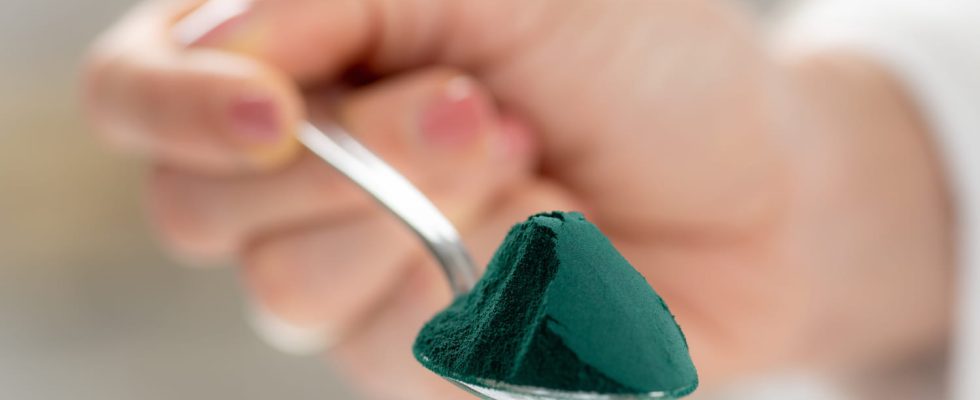Spirulina is a small algae that can be taken with water, in a smoothie, in cottage cheese, etc. It is appreciated for its many healthy nutrients.
Spirulina is a micro-algae available in the form of powder or tablets in organic stores or French pharmacies. We can drink from a glass of water or fruit juice or mix (when it is powder) with our meals (soups, Omelette, smoothie…). It is particularly appreciated for its rich in protein and iron but also in vitamins various. However, it is necessary to be careful regarding the purchase in the form of food supplements.
What is spirulina?
Spirulina is a soft, spiral-shaped microalgae, which belongs to the cyanobacteria family. She has existed for 3.5 billion years And grows naturally in the lakes ofIndia, Mexico or Chad. Used in the 13th century by the Incas and the Aztecs, Europeans discovered it during the conquest of Central America. It became extremely popular in the early 1970s in industrialized countries. Spirulina has been declared in 1974 “the best food for humanity in the 21st century” by the World Health Organization and “L’ideal and most complete food of tomorrow” by Unesco. Spirulina is used for food purposes (especially in Mexico and Chad), notably in the form of supplements, because of his nutritional potential, or like dye. She is also employed in animal feed.
What is its composition?
Three species of spirulina are included in the decree of June 24, 2014 establishing the list of plants, other than mushrooms, authorized in food supplements and the conditions of their employment (spirulina major, spirulina maxima, spirulina platensis). The species of spirulina the most sold is the Spirulina platensis. The particularity of this algae is to be both low in calories and rich in nutrients : vegetable proteins, carotenoids, iron, Vitamin B12 (but spirulina does not constitute a reliable source of vitamin B12 for populations excluding products of animal origin), vitamin E, potassium, calcium, chromium, copper, magnesiummanganese, phosphorus, selenium, sodium, zinc, fluorine, gamma-linolenic acid or even antioxidants.
→ The carbohydrate content of spirulina varies from 14 to 19% of dry matter.
→ The protein content ranges from 60 to 70% dry matter of spirulina with a high proportion of amino acids indispensable.
→ The total lipid content of spirulina (mainly in the form of di- and triglycerides) is generally less than 10%.
→ A very high iron content (100g of dried or dehydrated spirulina provides 28.5 mg of iron), which gives spirulina its nickname of “steak of the sea”.
What are the benefits of spirulina?
According to one Mexican study dating from 2009spirulina would have a real cardio-protective effect linked to its action on blood lipids. Spirulina would in fact promote the increase in HDL cholesterol (good cholesterol), the reduction in LDL cholesterol (bad cholesterol) and triglycerides.
The numerous antioxidants (phycocyanin and chlorophyll, responsible for its pretty blue-green color) make spirulina a food capable of boost immune systems at half mast, and give it anti-aging virtues.
A set ofpreliminary studies suggest a hypoglycemic effect spirulina in people with diabetes non-insulin dependent.
Finally, theexceptional protein content spirulina makes it very useful for undernourished people or vegetarians or vegans.
Does spirulina make you lose weight?
If spirulina has slimming benefits, it does not make you lose weight however. It is mainly high in protein (it contains 60%, or 3 times more than a beef steak!) which makes spirulina interesting as part of a diet. Proteins are filling and help you fight against muscle wasting often associated with weight loss. However, preserving your muscles is essential to maintain your healthy weight because it is what burns calories, even when resting. Another advantage of spirulina as part of a diet: its great richness in minerals and antioxidants, which make it possible to overcome deficiencies and keep in shape.
Who is spirulina recommended for?
Spirulina is recommended for:
- people with high cardiovascular risks,
- people with type 2 diabetes,
- people who have reduced or excluded animal proteins from their diet (flexitarians, vegetarians, vegans),
- people following a low-calorie diet,
- undernourished people,
- the people anemic (lack of iron)
- or teenagers.
How to store spirulina?
Spirulina can be stored for a long time without its nutritional qualities being affected, provided you take care to protect it from humidity ! So be careful to close your bag using a zip or pliers, or transfer it to an airtight container. It should ideally be stored away from heat and light.
Contraindications
Consumption of spirulina is not recommended for people suffering from phenylketonuria, those with excess uric acid, as well as those with allergic conditions. People with a ferritin level too high should avoid taking a course of spirulina.
Can spirulina be dangerous?
The risk of spirulina can come from its food supplements. “Products containing spirulina may be contaminated with cyanotoxins, bacteria or trace metal elements (lead, mercury, arsenic)“ explained theHandles in 2017. It recommends that consumers favor the best controlled supply circuits (pharmacies and French organic stores rather than websites which do not specify the origin of the products). “Apart from the risk of contamination, spirulina does not seem not present a health risk at low doses, up to several grams per day in adults.“
